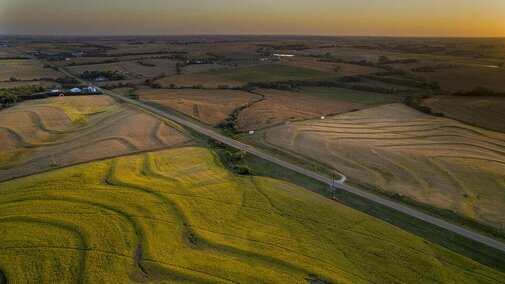The average value of agricultural land in Nebraska for the year ending Feb. 1, 2022, averaged $3,360 per acre, about a 16% increase ($465 per acre) over the prior year’s value of $2,895 per acre, according to the final report from the University of Nebraska–Lincoln’s 2022 Farm Real Estate Market Survey.
This marks the largest increase in the market value of agricultural land in Nebraska since 2014 and is the highest non-inflation-adjusted statewide land value in the history of the survey.
Crop prices, purchases for farm expansion and interest rate levels were identified in the report as the major economic forces that guided the higher market value of land across the state. The financial health of current owners and non-farmer investor interest in land purchases also played a role, according to survey results.
The survey’s final report was published June 30 by the university’s Center for Agricultural Profitability, based in the Department of Agricultural Economics. It provides current point-in-time estimates of agricultural land values and cash rental rates, broken down regionally across a variety of land types and classes.
Based on 2022 market values, the estimated total value of agricultural land and buildings in Nebraska rose to $161.2 billion, according to Jim Jansen, an agricultural economist with Nebraska Extension. He co-authored the survey and report with Jeffrey Stokes, a professor in the Department of Agricultural Economics.
“Despite rising input costs that remain a challenge for many operations, commodity prices for major crops grown across Nebraska rebounded significantly in 2022 with disruptions in supply chains and weather concerns,” Jansen said.
He added that producers with livestock face further challenges from drought conditions across major grazing regions, as well as higher feed expenses.
“Farmers may anticipate higher revenues from rising commodity prices but may face similar challenges as ranchers and livestock producers when navigating higher input expenses,” he said. “Farm or ranch profitability remains tied to making informed decisions.”
Rates of increase were the highest in the northwest, northeast, east, south and southeast districts as these areas averaged 15% to 21% higher for the all-land average. These districts trended along with the rate of increase of 16% for the state.
Western regions of Nebraska, including the north, central and southwest districts, reported smaller all-land average value increases ranging between 11% and 13%. The north district reported the smallest increase at 11%.
Statewide, the final report found that estimated values of center pivot irrigated cropland rose by about 17%. Dryland cropland values rose between 15% and 19%. Grazing land and hayland market values range from about 10% to 12% higher than the prior year.
Survey results also revealed that cash rental rates for dryland and irrigated cropland trended higher, averaging about 10% to 20% higher than the prior year. Survey participants indicated crop prices as the major factor contributing to the increase in rental rates.
Grazing land and cow-calf pair rental rates trended steady to higher, with average statewide rates increasing about 6% to 8% over the prior year.
The outlook for future gains in farm real estate values remain strong, according to Jansen, as only three economic forces were noted in the report as somewhat negatively impacting farm real estate values: property tax levels, farm input costs and future property tax policies.
The Nebraska Farm Real Estate Report is the final product of an annual survey of land professionals, including appraisers, farm and ranch managers and agricultural bankers. Results from the survey are divided by land class and agricultural statistic district. Land values and rental rates presented in the report are averages of survey participants’ responses by district. Actual land values and rental rates may vary depending on the quality of the parcel and local market for an area. Preliminary land values and rental rates are subject to change as additional surveys are returned.
Jansen will present the results of the final report during a free webinar at noon on Thursday, Aug. 4. Registration, as well as the full report, are available on the Center for Agricultural Profitability’s website.

